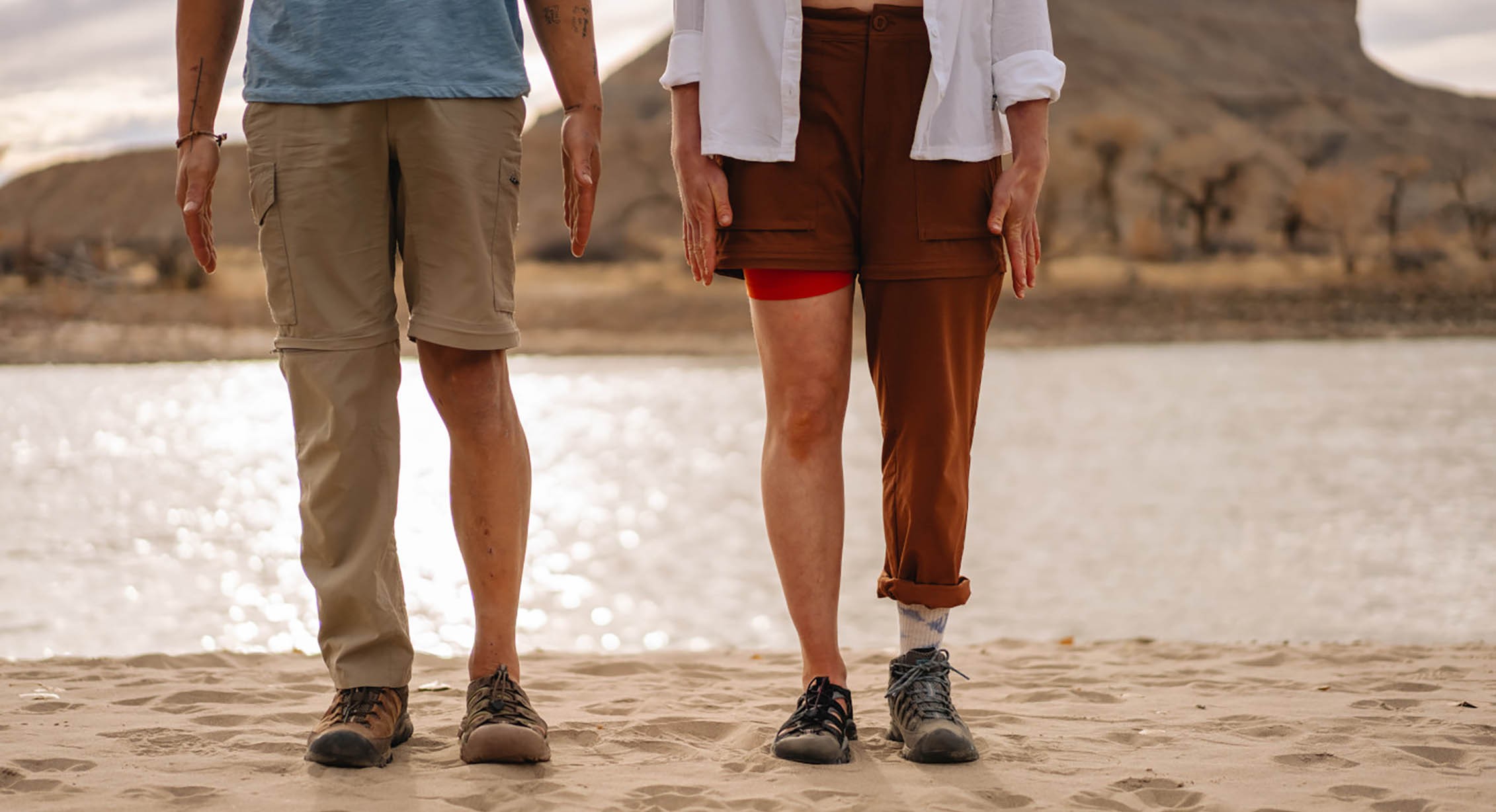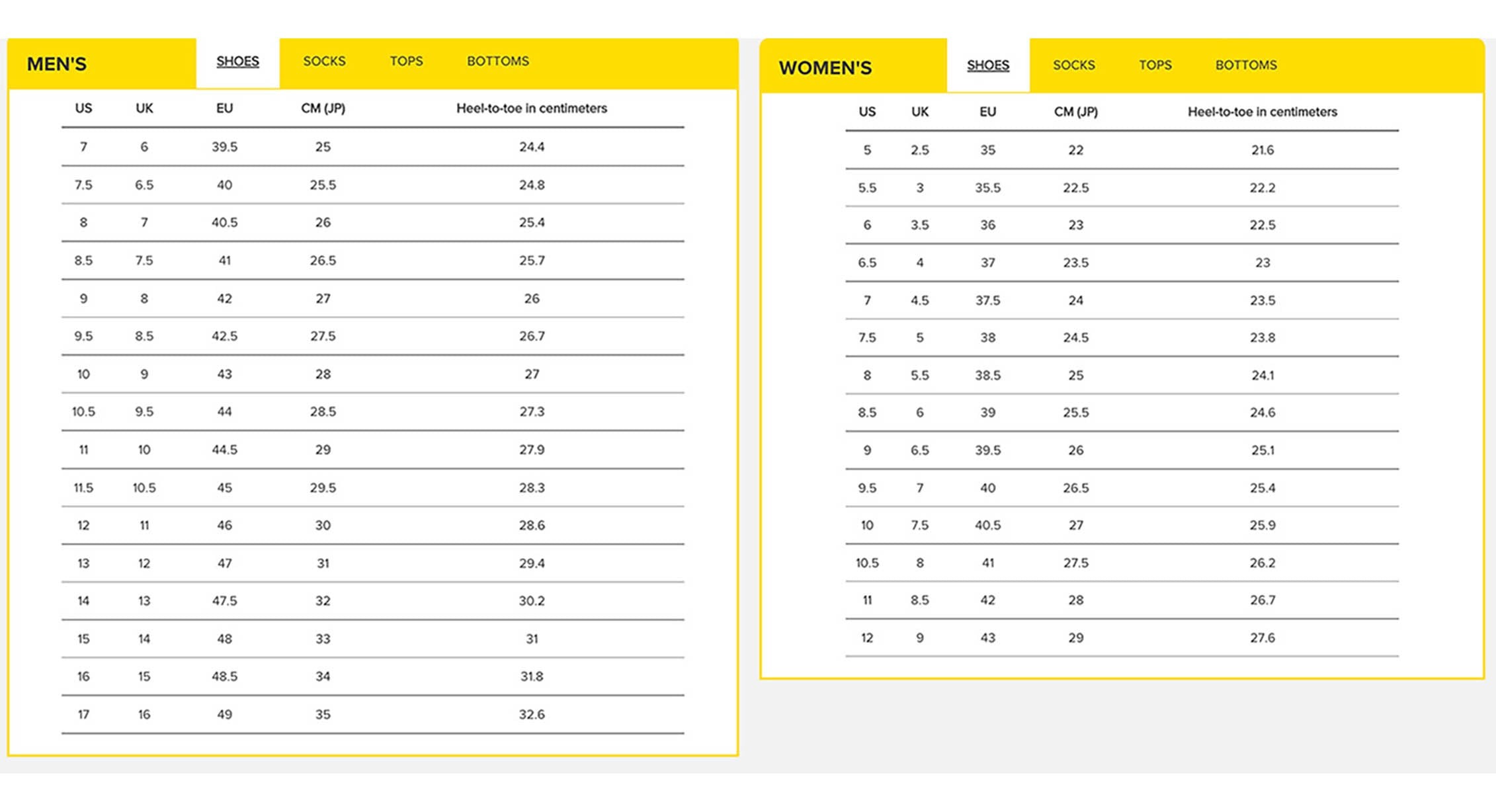How big are men’s shoes compared to women’s is a common query, and understanding the sizing differences can unlock a world of footwear possibilities. At COMPARE.EDU.VN, we provide a comprehensive guide to navigate the nuances of shoe sizing, ensuring you find the perfect fit regardless of gender labels. This information helps you get the right fit, including cross-gender fitting options and the correct shoe size conversions.
1. Understanding Men’s and Women’s Shoe Size Differences
The fundamental difference between men’s and women’s shoe sizes lies in the sizing scale used. Generally, men’s sizes are larger than women’s sizes for the same foot length. This difference isn’t arbitrary; it reflects the average anatomical differences between men’s and women’s feet. Men’s feet tend to be wider and longer, while women’s feet are often narrower with a higher arch. However, individual variations exist, and many people find that shoes marketed for the opposite gender fit them perfectly well. This is why understanding how to convert between sizes is so valuable.
1.1. The Size Conversion Rule: Men’s to Women’s and Vice Versa
The general rule for converting between men’s and women’s shoe sizes in the U.S. is to add 1.5 to a man’s size to get the equivalent women’s size. For instance, a men’s size 9 would roughly correspond to a women’s size 10.5. Conversely, to convert from women’s to men’s sizes, subtract 1.5 from the women’s size. Therefore, a women’s size 7 would be approximately a men’s size 5.5. It’s important to note that this is a general guideline, and variations can occur depending on the brand, style, and manufacturing standards.
1.2. Beyond Length: Width and Volume Considerations
While length is a primary factor in shoe sizing, width and volume are equally crucial for a comfortable and proper fit. Men’s shoes are typically designed with a wider footbed and more overall volume than women’s shoes. This accommodates the generally broader shape of men’s feet. Women’s shoes often have a narrower profile and a snugger fit in the heel area. When considering cross-gender sizing, it’s essential to factor in these differences, especially if you have particularly wide or narrow feet. Brands sometimes offer shoes in different widths (e.g., narrow, medium, wide), which can help bridge the gap between men’s and women’s sizing.
2. Detailed Size Conversion Charts
To provide a more accurate and comprehensive guide, here are detailed size conversion charts for U.S., UK, and European shoe sizes. These charts can be used as a reference when shopping for shoes across genders or from different regions.
2.1. U.S. Shoe Size Conversion Chart
| Men’s (US) | Women’s (US) | Foot Length (Inches) | Foot Length (cm) |
|---|---|---|---|
| 6 | 7.5 | 9.375 | 23.8 |
| 6.5 | 8 | 9.625 | 24.5 |
| 7 | 8.5 | 9.875 | 25.1 |
| 7.5 | 9 | 10 | 25.4 |
| 8 | 9.5 | 10.25 | 26 |
| 8.5 | 10 | 10.5 | 26.7 |
| 9 | 10.5 | 10.75 | 27.3 |
| 9.5 | 11 | 11 | 27.9 |
| 10 | 11.5 | 11.125 | 28.3 |
| 10.5 | 12 | 11.375 | 28.9 |
| 11 | 12.5 | 11.625 | 29.6 |
| 11.5 | 13 | 11.875 | 30.2 |
| 12 | 13.5 | 12.125 | 30.8 |
| 12.5 | 14 | 12.375 | 31.4 |
| 13 | 14.5 | 12.625 | 32.1 |
| 14 | 15.5 | 13.125 | 33.3 |
| 15 | 16.5 | 13.625 | 34.6 |
This chart provides a quick reference for converting between men’s and women’s shoe sizes in the U.S. system, along with corresponding foot lengths in inches and centimeters. Always consider that these are approximate values, and individual fit may vary.
2.2. UK Shoe Size Conversion Chart
| Men’s (UK) | Women’s (UK) | Foot Length (Inches) | Foot Length (cm) |
|---|---|---|---|
| 5.5 | 7 | 9.375 | 23.8 |
| 6 | 7.5 | 9.625 | 24.5 |
| 6.5 | 8 | 9.875 | 25.1 |
| 7 | 8.5 | 10 | 25.4 |
| 7.5 | 9 | 10.25 | 26 |
| 8 | 9.5 | 10.5 | 26.7 |
| 8.5 | 10 | 10.75 | 27.3 |
| 9 | 10.5 | 11 | 27.9 |
| 9.5 | 11 | 11.125 | 28.3 |
| 10 | 11.5 | 11.375 | 28.9 |
| 10.5 | 12 | 11.625 | 29.6 |
| 11 | 12.5 | 11.875 | 30.2 |
| 11.5 | 13 | 12.125 | 30.8 |
| 12 | 13.5 | 12.375 | 31.4 |
| 13 | 14.5 | 12.625 | 32.1 |
| 14 | 15.5 | 13.125 | 33.3 |
| 15 | 16.5 | 13.625 | 34.6 |
This chart is helpful for those who are familiar with the UK shoe sizing system. Remember to consider foot length as the most accurate measure, and use the chart as a guide.
2.3. European Shoe Size Conversion Chart
| Men’s (EU) | Women’s (EU) | Foot Length (Inches) | Foot Length (cm) |
|---|---|---|---|
| 39 | 40 | 9.375 | 23.8 |
| 39.5 | 40.5 | 9.625 | 24.5 |
| 40 | 41 | 9.875 | 25.1 |
| 40.5 | 41.5 | 10 | 25.4 |
| 41 | 42 | 10.25 | 26 |
| 41.5 | 42.5 | 10.5 | 26.7 |
| 42 | 43 | 10.75 | 27.3 |
| 42.5 | 43.5 | 11 | 27.9 |
| 43 | 44 | 11.125 | 28.3 |
| 43.5 | 44.5 | 11.375 | 28.9 |
| 44 | 45 | 11.625 | 29.6 |
| 44.5 | 45.5 | 11.875 | 30.2 |
| 45 | 46 | 12.125 | 30.8 |
| 45.5 | 46.5 | 12.375 | 31.4 |
| 46 | 47 | 12.625 | 32.1 |
| 47 | 48 | 13.125 | 33.3 |
| 48 | 49 | 13.625 | 34.6 |
For those in Europe or buying European brands, this chart will be invaluable. As with the other charts, always double-check the specific brand’s sizing guide if available.
3. How to Measure Your Feet Accurately
The most reliable way to determine your shoe size is to measure your feet accurately. Here’s a step-by-step guide:
3.1. Materials Needed for Foot Measurement
- A piece of paper larger than your foot
- A pencil or pen
- A ruler or measuring tape
- Socks (wear the type of socks you would typically wear with the shoes you plan to buy)
3.2. Step-by-Step Guide to Measuring Your Feet
- Prepare the Paper: Place the piece of paper on a hard, flat surface.
- Position Your Foot: Stand with one foot firmly on the paper, ensuring your weight is evenly distributed.
- Trace Your Foot: Using the pencil or pen, carefully trace the outline of your foot. Keep the pen perpendicular to the paper to ensure an accurate tracing.
- Measure the Length: Use the ruler or measuring tape to measure the distance from the heel to the longest toe. This is your foot length.
- Measure the Width: Measure the width of your foot at the widest point.
- Repeat for the Other Foot: Repeat the process for your other foot, as foot sizes can vary slightly.
- Compare to Size Chart: Use the larger of the two measurements and compare it to the size charts provided earlier to find your corresponding shoe size.
3.3. Common Mistakes to Avoid When Measuring
- Measuring your feet while sitting down, as your feet expand when you stand.
- Not wearing socks when measuring, which can affect the accuracy of the measurement.
- Tracing your foot at an angle, which can distort the outline and lead to an incorrect measurement.
- Assuming both feet are the same size; always measure both and use the larger measurement.
4. Brand-Specific Sizing Variations
While the general size conversion rules provide a starting point, it’s crucial to recognize that shoe sizes can vary significantly between brands. This is due to differences in manufacturing processes, design aesthetics, and target markets. Some brands may run smaller or larger than others, while some may have a narrower or wider fit.
4.1. Why Do Sizes Differ Between Brands?
Several factors contribute to size variations between brands:
- Manufacturing Standards: Different brands may adhere to different manufacturing standards, leading to inconsistencies in sizing.
- Design and Style: The design and style of a shoe can affect its fit. For example, a pointed-toe shoe may feel tighter than a round-toe shoe, even if they are the same size.
- Target Market: Brands that cater to specific demographics may adjust their sizing to better fit their target customers.
- Materials Used: The materials used in shoe construction can also affect sizing. Leather shoes, for example, may stretch over time, while synthetic materials may not.
4.2. How to Find Brand-Specific Size Charts
The best way to ensure an accurate fit is to consult the brand’s specific size chart. Most reputable shoe brands provide detailed size charts on their websites, which include measurements in both inches and centimeters. To find a brand-specific size chart, simply visit the brand’s website and look for a “Size Guide” or “Sizing Chart” link. You can also try searching online for “[Brand Name] Size Chart.”
4.3. Reading Customer Reviews for Sizing Clues
In addition to size charts, customer reviews can provide valuable insights into a brand’s sizing tendencies. Many online retailers allow customers to leave reviews and comments about the products they have purchased. Pay attention to reviews that mention sizing issues, such as “runs small,” “runs large,” or “narrow fit.” These comments can help you make a more informed decision about which size to order.
5. The Impact of Shoe Style on Sizing
The style of the shoe can also influence the fit and sizing. Different shoe styles are designed with different purposes in mind, and this can affect how they fit on your feet.
5.1. Sneakers vs. Dress Shoes
Sneakers and dress shoes often have different sizing considerations. Sneakers are typically designed to be more comfortable and accommodating, with a roomier fit. Dress shoes, on the other hand, may have a more snug and structured fit. As a result, you may need to adjust your size when switching between these two styles. For example, you might wear a size 9 in sneakers but a size 9.5 in dress shoes.
5.2. Sandals vs. Boots
Sandals and boots also have unique sizing considerations. Sandals are generally more forgiving in terms of fit, as they expose more of the foot. However, it’s important to ensure that your toes don’t hang over the edge of the sandal and that the straps are not too tight or too loose. Boots, on the other hand, can be more challenging to fit, especially if you have wide calves. It’s important to measure your calf circumference and consult the boot’s sizing chart to ensure a proper fit.
5.3. Athletic Shoes vs. Casual Shoes
Athletic shoes and casual shoes are designed for different activities, and this can affect their fit. Athletic shoes are typically designed to provide support and cushioning for high-impact activities, such as running or basketball. They often have a snug fit to prevent slippage and provide stability. Casual shoes, on the other hand, are designed for everyday wear and may have a more relaxed fit. When choosing athletic shoes, it’s important to consider the specific activity you will be using them for and choose a size that provides adequate support and cushioning.
6. Gender-Neutral Shoe Options
In recent years, there has been a growing trend towards gender-neutral clothing and footwear. Many brands are now offering shoes that are designed to be worn by anyone, regardless of gender.
6.1. Brands Offering Unisex Shoe Styles
Several brands have embraced the gender-neutral movement and are offering unisex shoe styles. These shoes are typically designed with a more neutral aesthetic and are available in a wider range of sizes to accommodate both men’s and women’s feet. Some popular brands offering unisex shoe styles include:
- Dr. Martens: Known for their iconic boots and shoes, Dr. Martens offers many styles that are suitable for both men and women.
- Converse: The classic Converse Chuck Taylor All Stars are a timeless unisex shoe that has been popular for decades.
- Vans: Vans offers a variety of unisex shoe styles, including their classic slip-ons and skate shoes.
- Birkenstock: Birkenstock sandals are known for their comfort and durability, and they are available in unisex sizes.
- New Balance: Several New Balance styles are available in unisex sizing, offering a blend of comfort and performance.
6.2. What to Look for in a Gender-Neutral Shoe
When shopping for gender-neutral shoes, there are several factors to consider:
- Neutral Aesthetic: Look for shoes with a neutral aesthetic that is not overly feminine or masculine.
- Wide Size Range: Ensure that the shoes are available in a wide range of sizes to accommodate both men’s and women’s feet.
- Comfort: Choose shoes that are comfortable and provide adequate support for your feet.
- Durability: Look for shoes that are made from high-quality materials and are built to last.
6.3. The Benefits of Gender-Neutral Footwear
Gender-neutral footwear offers several benefits:
- Increased Choice: It provides more options for people who don’t want to be limited by traditional gender norms.
- Improved Fit: It allows people to find shoes that fit their feet properly, regardless of gender.
- Reduced Waste: It can reduce waste by allowing people to share shoes with family members or partners of different genders.
- Expression of Individuality: It allows people to express their individuality and personal style without being constrained by gender stereotypes.
7. Online Shoe Shopping Tips
Online shoe shopping can be convenient, but it also presents some challenges, particularly when it comes to sizing. Here are some tips to help you navigate the online shoe shopping experience:
7.1. Read the Product Description Carefully
Before ordering shoes online, read the product description carefully. Pay attention to any notes about sizing, fit, or materials. Look for information about whether the shoes run small, large, narrow, or wide.
7.2. Check the Retailer’s Size Chart
Most online retailers provide size charts for the shoes they sell. Be sure to check the retailer’s size chart before ordering to ensure that you are selecting the correct size. Keep in mind that size charts can vary between retailers, so it’s always best to check the specific chart for the retailer you are shopping with.
7.3. Read Customer Reviews
Customer reviews can provide valuable insights into the sizing and fit of shoes. Pay attention to reviews that mention sizing issues or comfort problems. Look for patterns in the reviews to get a sense of whether the shoes tend to run small, large, narrow, or wide.
7.4. Measure Your Feet Before Ordering
As mentioned earlier, measuring your feet is the most reliable way to determine your shoe size. Measure your feet before ordering shoes online to ensure that you are selecting the correct size.
7.5. Understand the Retailer’s Return Policy
Before ordering shoes online, make sure you understand the retailer’s return policy. Check to see if the retailer offers free returns and how long you have to return the shoes if they don’t fit properly.
7.6. Try On Shoes Indoors
When your shoes arrive, try them on indoors on a carpeted surface. This will help prevent the soles from getting dirty and make it easier to return the shoes if they don’t fit.
8. Foot Health and Shoe Fit
Proper shoe fit is essential for maintaining foot health. Wearing shoes that are too small, too large, too narrow, or too wide can lead to a variety of foot problems.
8.1. Common Foot Problems Caused by Poorly Fitted Shoes
- Blisters: Blisters are caused by friction between the shoe and the skin. They can occur when shoes are too tight or too loose, allowing the foot to slide around inside the shoe.
- Bunions: Bunions are bony bumps that form on the joint at the base of the big toe. They are often caused by wearing shoes that are too narrow or pointed.
- Hammertoes: Hammertoes are deformities of the toes that cause them to bend at the middle joint. They are often caused by wearing shoes that are too short or too tight.
- Ingrown Toenails: Ingrown toenails occur when the edges of the toenail grow into the surrounding skin. They are often caused by wearing shoes that are too tight or too narrow.
- Plantar Fasciitis: Plantar fasciitis is inflammation of the plantar fascia, a thick band of tissue that runs along the bottom of the foot. It is often caused by wearing shoes that don’t provide adequate support.
8.2. The Importance of Proper Arch Support
Arch support is essential for maintaining foot health. The arch of the foot helps to distribute weight evenly and absorb shock. Wearing shoes that don’t provide adequate arch support can lead to foot pain, fatigue, and other problems.
8.3. When to See a Podiatrist
If you are experiencing foot pain or other foot problems, it’s important to see a podiatrist. A podiatrist is a medical doctor who specializes in the diagnosis and treatment of foot and ankle conditions. They can help you determine the cause of your foot problems and recommend appropriate treatment options.
9. Special Considerations for Specific Foot Conditions
Some people have specific foot conditions that require special considerations when choosing shoes.
9.1. Wide Feet
If you have wide feet, it’s important to choose shoes that are specifically designed for wide feet. Look for shoes that are labeled as “wide” or “extra wide.” You may also need to go up a size to accommodate the width of your feet.
9.2. Flat Feet
If you have flat feet, it’s important to choose shoes that provide adequate arch support. Look for shoes that have a firm midsole and a supportive footbed. You may also want to consider using orthotic inserts to provide additional arch support.
9.3. High Arches
If you have high arches, it’s important to choose shoes that provide cushioning and shock absorption. Look for shoes that have a cushioned midsole and a flexible outsole. You may also want to consider using orthotic inserts to provide additional cushioning.
9.4. Bunions and Hammertoes
If you have bunions or hammertoes, it’s important to choose shoes that have a wide toe box. This will help prevent pressure on the bunions and hammertoes. You may also want to consider using orthotic inserts to provide additional cushioning and support.
10. Conclusion: Finding the Perfect Fit
Finding the perfect shoe fit can be a challenge, but it’s well worth the effort. By understanding the differences between men’s and women’s shoe sizes, measuring your feet accurately, considering brand-specific sizing variations, and paying attention to shoe style and foot health, you can find shoes that fit comfortably and support your feet. And remember, at COMPARE.EDU.VN, we’re here to help you make informed decisions about all your comparison needs, including finding the right footwear.
10.1. The Importance of Prioritizing Comfort
Ultimately, the most important thing is to prioritize comfort. Choose shoes that feel good on your feet and allow you to move freely. Don’t sacrifice comfort for style, as poorly fitted shoes can lead to foot pain and other problems.
10.2. Trust Your Instincts
When trying on shoes, trust your instincts. If the shoes don’t feel right, don’t buy them. Keep searching until you find a pair that fits perfectly and feels great on your feet. Remember, size is just a number; the fit is what truly matters.
10.3. Visit COMPARE.EDU.VN for More Shoe Comparisons
Still unsure about the best shoe for your needs? Visit COMPARE.EDU.VN for more detailed comparisons of various shoe brands, styles, and features. Our comprehensive guides and user reviews will help you make an informed decision and find the perfect fit for your unique feet. Don’t let confusing sizing charts hold you back from the perfect pair. Let COMPARE.EDU.VN guide you to your best fit!
FAQ: Frequently Asked Questions about Shoe Sizing
1. How do I convert women’s shoe sizes to men’s?
To convert women’s shoe sizes to men’s, subtract 1.5 from the women’s size. For example, a women’s size 8 would be approximately a men’s size 6.5.
2. How do I convert men’s shoe sizes to women’s?
To convert men’s shoe sizes to women’s, add 1.5 to the men’s size. For example, a men’s size 10 would be approximately a women’s size 11.5.
3. Do shoe sizes vary between brands?
Yes, shoe sizes can vary significantly between brands. It’s always best to check the brand’s specific size chart before ordering shoes online.
4. How do I measure my feet accurately?
To measure your feet accurately, place a piece of paper on a hard, flat surface. Stand with one foot firmly on the paper and trace the outline of your foot. Measure the distance from the heel to the longest toe.
5. What should I do if my shoes don’t fit properly?
If your shoes don’t fit properly, return them to the retailer for a refund or exchange.
6. What are the common foot problems caused by poorly fitted shoes?
Common foot problems caused by poorly fitted shoes include blisters, bunions, hammertoes, and ingrown toenails.
7. How important is arch support in shoes?
Arch support is essential for maintaining foot health. Wearing shoes that don’t provide adequate arch support can lead to foot pain, fatigue, and other problems.
8. What are gender-neutral shoe options?
Gender-neutral shoe options are shoes that are designed to be worn by anyone, regardless of gender.
9. How can online shoe shopping be made easier?
Online shoe shopping can be made easier by reading the product description carefully, checking the retailer’s size chart, reading customer reviews, and measuring your feet before ordering.
10. When should I see a podiatrist about my feet?
You should see a podiatrist if you are experiencing foot pain or other foot problems. A podiatrist can help you determine the cause of your foot problems and recommend appropriate treatment options.
For more detailed information and comparisons on shoe sizes and brands, visit COMPARE.EDU.VN at 333 Comparison Plaza, Choice City, CA 90210, United States. You can also reach us via Whatsapp at +1 (626) 555-9090. We are here to assist you in making the best choices for your footwear needs. Let compare.edu.vn guide you toward the perfect fit!



